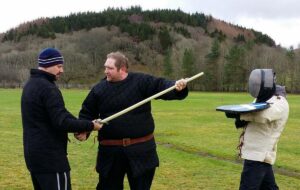 David Britten,
David Britten,
Arms instructor of Team Scotland
The strangest thing about me is that I have never been interested in HMB. I am an instructor (and a pretty disreputable one) for historical European martial arts. My club is called “Glasgow Company of Duellists.” We specialize in the longsword fighting based on the works of a German fencing masters of XIII-XIVth centuries, Johannes Liechtenauer, and, of course, in the Scottish basket-hilted sword.
As fate and Dave McNaughton willed, I became a member of the National Team of Scotland in 2014. I was invited by Dave McNaughton, the captain, who was trying to form a team, but lacked experience concerning weapons. He took his novices to my club, we gave them basic training, and then beat them with swords mercilessly :). Then Dave realized he could use our knowledge to train his fighters the art of weapon handling, and I realized that he would not leave me alone until I agree.
The beginning was quite sad! First, we had serious problems with attracting new people. The world of Scottish reenactment is full of wimps and posers, and, despite our repeated attempts to get them involved in HMB, no one became interested. The Association of Historical European and general martial arts was also a mire. Frankly speaking, I was ashamed of my countrymen. It was only due to the persistence of Dave that the team was formed.
But our problems continued! The second major problem faced by Team Scotland was lack of armor and weapons. At first we used my personal equipment and weapons of the “Glasgow Company of Duellists” club.
And finally the team was formed! It took more than a year of hard work to recruit a sufficient number of fighters. Within that time Dave got armor and weapons. He also arranged for a training room in an army camp, and we started training regional groups. I was responsible for the training of the team in Glasgow, and attended as many national training events as I could.
I had to do some research preparing the training regime for the team. I began with watching videos on YouTube. The first thing I noticed was that HMB had very little to do with the art of medieval sword fighting. According to my observations, it appeared that most of the teams won thanks to wrestling techniques and tricks from different martial arts, so I wanted to change the situation. I began to teach the basics of fencing, paying particular attention to the footwork and concentration of strength. The idea was that the correct position of the feet would improve stability in a battle, and that hard blows could knock the opponent down.
The basic concepts that I have taught my men, were the following:
– Measure
It’s very difficult in the middle of a battle to judge the optimal distance to strike a blow with your weapon. Too far – and you miss, too close – and the blow lacks power. So I developed exercises to get the guys used to measure distances instinctively.
– Triangular Entry
This medieval footwork method has a two-fold benefit. It increases the power of the weapon cut while simultaneously taking you off the line and giving you some advantages over a charging opponent. It engages the core muscle groups to power the weapon rather than arms, so it puts the fighter’s entire body weight into the blow.
– Seizing the initiative
In medieval combat (unlike boxing or wrestling) it is ill advised to counter-fight. Any blow you take can be disabling or disorientating. So we trained to attack first, aggressively and forcefully.
– Spatial Awareness
Spatial awareness is one of the great challenges for a fighter wearing armor. So I tried to train the fighters to keep their heads up and constantly look around. Look for an opportunity of attack. Sometimes it’s worth to break engagement and attack another fighter, who is more vulnerable, or to support a struggling team mate.
– Armour Reliance
One of the flaws I noticed in team was willingness of the guys to trade blows and rely on the armour (this is especially prevalent in the “1 v 1” bouts). I wanted Team Scotland to defend with their weapons and footwork and only have the armour for the last line of defence.
Our major success was that we got the team to Croatia where the guys did their best. Despite the fact that most of the team had never trained in armour before the event, we managed to get several wins. Also, no one was seriously wounded. It was also the first time when our men participated in the HMB event. I think the Team did its best.
However, there were some drawbacks. The guys lacked sparring experiences and weapons handling skills, that’s why they were losing. Some of the fitness programs we adopted focused on aerobic fitness rather than strength and anaerobic fitness. I hope we will correct these issues and attract more people in the coming year.
The outcome of the National Team of Scotland’s participation in the HMB World Championship “Battle of the Nations”-2014 held in Croatia is the fact that now we have experienced fighters and several complete sets of armor. I returned to my group of European historical martial arts. In addition, I am now dealing with the implementation of an ambitious project, namely we want to produce our own armor and weapons in Scotland, and open a repair shop. We are very lucky to have here, in Glasgow, a research center of the world level, led by Dr. Ralph Moffat and specializing in medieval armor and weapons. This world-known expert on European weapons and armor supervises museum collections of medieval military equipment, as well as books and manuscripts on the subject. So we expect to produce high-quality armor and weapons on the basis of original artifacts kept in Glasgow.
2021